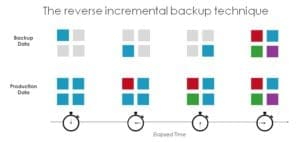 There’s a common misconception that backup techniques are interchangeable. Nothing could be further from the truth. Numerous backup techniques have evolved over time, each leveraging available technology and optimized to suit different requirements, use cases, and environments. Many techniques offer either efficient backup or reliable recovery. Reverse incremental, a lesser-known technique, enables both. To explain how it works, let’s compare it to two commonly-used backup techniques: full and incremental.
There’s a common misconception that backup techniques are interchangeable. Nothing could be further from the truth. Numerous backup techniques have evolved over time, each leveraging available technology and optimized to suit different requirements, use cases, and environments. Many techniques offer either efficient backup or reliable recovery. Reverse incremental, a lesser-known technique, enables both. To explain how it works, let’s compare it to two commonly-used backup techniques: full and incremental.
The Full Backup – simple but inefficient
How it works: Each full backup operation creates a bit-identical image (or mirror) of production data. The mirror can be a disk or a networked storage system on-premises, a storage target at a remote location, or a data center in the cloud. Should trouble arise, users can recover data by restoring the most recent mirror into the production environment.
Disadvantages: Because full backups are as large as the source data they mirror, they tend to consume a tremendous amount of storage. As data grows, backup traffic can strain networks, especially when backing up to remote sites or to the cloud. Large backup workloads can also lead to long backup windows, which in turn can increase the risk of data loss.
The Incremental Backup – efficient backups, compromised recoveries
How it works: Incremental backups only capture the changes (or deltas) between source data and the most recent full backup. This results in faster performance and higher efficiency than with full backups under most conditions.
 Disadvantages: Unfortunately, when trouble strikes, restoring the most recent backup image is more complex and riskier because restoration requires combining data from a series of backup images. Because resuming operations depends on the successful processing of multiple backup images, the corruption of even a single incremental image can lead to a recovery failure and critical business loss.
Disadvantages: Unfortunately, when trouble strikes, restoring the most recent backup image is more complex and riskier because restoration requires combining data from a series of backup images. Because resuming operations depends on the successful processing of multiple backup images, the corruption of even a single incremental image can lead to a recovery failure and critical business loss.
The Reverse Incremental Backup – efficient backups and reliable recoveries
How it works: The reverse incremental technique resembles the standard incremental technique in its reliance on incremental images. However, after capturing each delta, the reverse incremental backup technique proceeds to synthesize a full mirror image and make it available for recovery. When the need arises to perform a recovery, this synthetic mirror image is restored to the production environment, similar to recovery with full backups.
Advantages: The reverse incremental technique offers the high efficiency of the incremental technique during backup and the high reliability of the full technique during recovery. Because mirror images are synthesized during backup, the reassembly process will not compete with more urgent disaster recovery operations.
Intronis leverages the reverse incremental technique for several of our advanced data protection services. Our implementation of the reverse incremental technique helps you, our IT service provider partners, deliver a backup and recovery experience that is highly satisfying for your clients.
Watch the video
To help explain reverse incremental backup even further, we produced a four-minute video that provides an easy-to-understand graphical representation of the technique.
